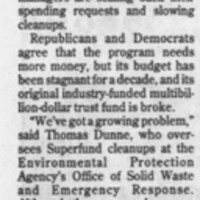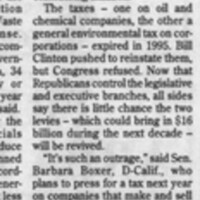Early Superfund: Finance and Litigation
Dublin Core
Title
Early Superfund: Finance and Litigation
Subject
Superfund progress and dialogue in the Argus-Leader, a Sioux Falls Newspaper
Description
The article “Federal Cleanup Program is Failing to Address Needs” from Sioux Falls Argus-Leader Newspaper, 2004, illuminates the financial shortcomings of the EPA Superfund programming, importantly highlighting its impact on the Omaha Lead Site. The general sentiment of the project's progress can be seen simply in the end of the first piece (left) “Superfund financing is not so super”, which concludes with a worryingly trite instruction from EPA Superfund Officials to Omaha Cleanup planners: “reduce the scope, phase or delay planned activities where possible”.
Around the country during this time period, more and more corporate pollution hazards were becoming uncovered to the public eye, as referenced by Thomas Dunne, who oversees the EPA’s Emergency Response Office. “We’ve got a growing problem”, Dunne says, explaining the ongoing limitations of the program's funding. With so many communities around the country suffering from corporate pollution, the need for more and more cleanup funding adversely affects even communities previously recognized to be in need of federal assistance. The case of the Omaha lead cleanup is a particularly dire situation. Here, the Sioux Falls Argus-Leader demonstrates that early Superfund financing simply did not meet the needs of Superfund sites across the country, directly contributing to program cutbacks and delays in projects such as the Omaha Lead Cleanup.
So what are the underlying causes of these financing issues in the early Superfund program? In fact, these were a result of historical legislative problems surrounding corporate taxes - the source of a huge portion of site cleanup funding. The second piece of the article (right) explains: “the taxes - one on oil and chemical companies, the other a general environmental tax on corporations - expired in 1995”. Now the timeline is becoming clear. The Omaha Lead site was designated a Superfund site in 1999, recently after tax cuts crippled EPA Superfund spending power. Omahians in lead cleanup areas are hence directly affected by purposefully slowed clean up rates and project scope minimization as a direct result of corporate tax cuts, only years before the site was designated as an EPA Superfund site.
Unfortunately, examples of this damage are not hard to come by, the rate of yard cleanup in Omaha is an example cited later in the same article. At the time The Argus-leader published this newspaper, the EPA was conducting yard cleanups at a rate of 10 contaminated yards a week, at a price of 13 to 16 thousand dollars per yard. Over 80 thousand residents lived in the Omaha Lead Site area, and with this cleanup rate, dictated by budget cutbacks, many residents would not see direct help for an unpredictable amount of time.
Around the country during this time period, more and more corporate pollution hazards were becoming uncovered to the public eye, as referenced by Thomas Dunne, who oversees the EPA’s Emergency Response Office. “We’ve got a growing problem”, Dunne says, explaining the ongoing limitations of the program's funding. With so many communities around the country suffering from corporate pollution, the need for more and more cleanup funding adversely affects even communities previously recognized to be in need of federal assistance. The case of the Omaha lead cleanup is a particularly dire situation. Here, the Sioux Falls Argus-Leader demonstrates that early Superfund financing simply did not meet the needs of Superfund sites across the country, directly contributing to program cutbacks and delays in projects such as the Omaha Lead Cleanup.
So what are the underlying causes of these financing issues in the early Superfund program? In fact, these were a result of historical legislative problems surrounding corporate taxes - the source of a huge portion of site cleanup funding. The second piece of the article (right) explains: “the taxes - one on oil and chemical companies, the other a general environmental tax on corporations - expired in 1995”. Now the timeline is becoming clear. The Omaha Lead site was designated a Superfund site in 1999, recently after tax cuts crippled EPA Superfund spending power. Omahians in lead cleanup areas are hence directly affected by purposefully slowed clean up rates and project scope minimization as a direct result of corporate tax cuts, only years before the site was designated as an EPA Superfund site.
Unfortunately, examples of this damage are not hard to come by, the rate of yard cleanup in Omaha is an example cited later in the same article. At the time The Argus-leader published this newspaper, the EPA was conducting yard cleanups at a rate of 10 contaminated yards a week, at a price of 13 to 16 thousand dollars per yard. Over 80 thousand residents lived in the Omaha Lead Site area, and with this cleanup rate, dictated by budget cutbacks, many residents would not see direct help for an unpredictable amount of time.
Creator
AP, Argus-Leader
Source
Argus-Leader Newspaper cited from Newspapers.com
Publisher
Argus-Leader
Date
November 26th, 2004
Contributor
Ben Schauer
Format
digital image
Language
English
Type
Digital Media
Still Image Item Type Metadata
Original Format
Newspaper Article Digital Clipping
Citation
AP, Argus-Leader, “Early Superfund: Finance and Litigation,” History of Environmental Inequalities, accessed May 7, 2024, https://steppingintothemap.com/inequalities/items/show/139.
Embed
Copy the code below into your web page

